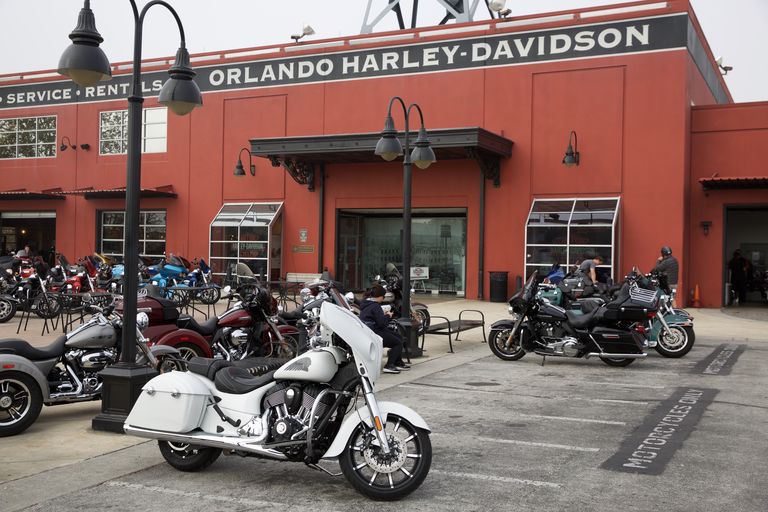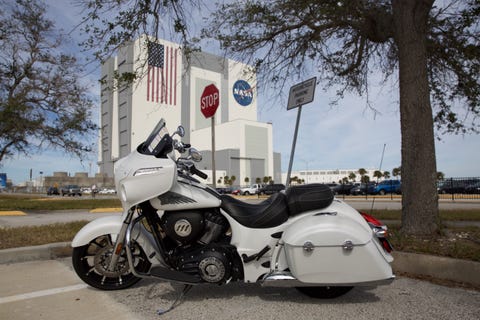Indian Motorcycle Is Coming for Harley-Davidson's Throne
The Polaris-owned bike builder is establishing its foothold in American motorcycles.
By Jay Bennett

JAY BENNETT
America's best-known motorcycle brand is having trouble at home. Harley-Davidson's U.S. sales are down to the lowest levels in years, and the company's stock has fallen about 13 percent so far in 2018. The Milwaukee-based bike builder is shuttering a factory in Kansas City as forecasts for 2018 predict continued declines. International sales have fared better, but possible steel and aluminum tariffs threaten to rock the manufacturer overseas.
The underlying problem that has plagued Harley for years is the slow demise of its core rider group—the bandana-clad riders rolling through curvy backwood highways, traveling in packs from bar to bar across America. They're getting older, and younger riders are opting for snappier, sportier, and cheaper bikes. Harley is hoping to right the ship with some help from its recently-announced electric motorcycle, the production bike that will result from the LiveWire prototype unveiled in 2014. But it remains to be seen if the sporty electric two-wheeler will have broader appeal.
And there is another threat to Harley's throne. Indian Motorcycle's ability to rival the name Harley-Davidson in classic American motorcycle lore—combined with the versatility and experience of its parent company, Polaris Industries, in building machines for many different types of riders—presents perhaps the biggest challenge to Harley's reign in decades. The race for America's biker soul is revving up.
An American Motorcycle Rematch
Indian Motorcycle was founded in 1901, and Harley-Davidson two years later. Both companies built groundbreaking bikes, delivering motorcycles to police forces, racing them on the dirt track, providing a simple alternative to the automobile, and serving in both world wars. By 1953, however, Harley-Davidson had caught the post-war economic wave and Indian had not. Indian went bankrupt and shut down. Previous attempts to revive the brand have all failed, but since Minnesota-based Polaris bought the brand name in 2011, growth has been explosive.
Harley-Davidson still holds the lion's share of sales, with about 50 percent of the U.S. market for big bikes, while Indian Motorcycle only recently broke into double digits. Indian sales are growing, however, and Polaris has thrown its full manufacturing and marketing support behind the brand after shutting down its popular Victory Motorcycles line. The experience Polaris gained building Victory bikes, its first foray into street cruisers after success building ATVs and snowmobiles, allowed the new Indian to hit the ground with the throttle wide open.
I recently rode a matte white Indian Chieftain on a tour of Florida, from Tampa down state highway 60 to route 1 up the Atlantic Coast to reach Cape Canaveral. The most appealing feature to people I met on the road might have been that the bike wasn't a Harley. Half the cruisers out there are Harleys, most of them black. Truckers, gas station attendants, and toll booth employees were constantly commenting on the Indian bike and coming over for a closer look.

JAY BENNETT
Performance-wise, there is no doubt Indian is holding its own. The Chieftain's 111-cubic-inch (1,811 cc) Thunder Stroke V-Twin puts out 119 ft-lbs. of torque, smoking people off the line, providing plenty of pick-me-up for clean passes, and holding stable lines through curvy roads. The modern engineering comes packaged in a classic-looking bike with more rounded angles than a Harley Street Glide, from the front fender to the V-twin to the saddlebags, making it immediately distinguishable—familiar yet different. I've never been a big fan of touchscreens on bikes—you ride a motorcycle because you don't want to be in a car—but the GPS was intuitive and easy to follow. I certainly enjoyed rolling into Kennedy Space Center with Sturgill Simpson blasting on the handlebar-mounted stereo system a little too loud.
While Indian and Harley duke it out in the bagger market, they are also taking their rivalry back to the dirt track with custom-built Flat Track racers, the Indian Scout FTR 750 and Harley XG750R. These performance versions of the Scout and Roadster are also designed to entice younger riders looking for more action at a cheaper price. The Chieftain has an MSRP of $21,500, and a Street Glide runs about the same. A Scout or Roadster will run you about $12,000. That's all great for successful middle-aged riders who are looking to fill up the four-door garage, but for younger riders, dipping into the double-digit thousands for a motorcycle usually isn't an option.
Next Generation
My dad has a 1999 Harley Road King Classic. I grew up around that bike. I knocked it over with my bicycle as a kid, an event that left me frantically scrambling in a futile attempt to lift it back up as I feared for my life. I rode it for the first time when I was 17, swapping my Triumph America with my old man as we made our way from Seattle to Yosemite and back. A couple years ago, that Road King, with more than 30,000 miles on it, had an overheated bearing burst to shreds and tear up the insides of the cylinders. After test riding new bikes and considering his options, my dad had a custom shop called Cyclepath bore out new cylinders and fit a new crankshaft into the same engine, increasing the displacement from 88 cubic inches to 103. He hung the old pistons on the garage wall.
In other words, dad's a Harley rider. He'll probably put another 30,000 miles on that Road King before he trades it in. But the next generation of cross-country haulers might be Indian riders.
Dropping off the Chieftain in Orlando, the shop employee who gave me a ride to the airport in his truck told me about how Victory Motorcycles had moved in on one of Harley's historically loyal markets: cop bikes. Police departments from Florida to Oregon have purchased Victory fleets in the past few years. Polaris offered greater versatility, repair support, and customization options for law enforcement, according to the bike mechanic, convincing many local police forces to jump ship from Harley. We speculated that soon, Polaris will likely be petitioning police officers to consider new Indian fleets.
"Harley is very hesitant to change anything, kinda stuck in their ways, and Harley riders don't want anything to change," he said. "Polaris is a lot better at being adaptable."
No comments:
Post a Comment